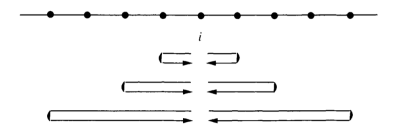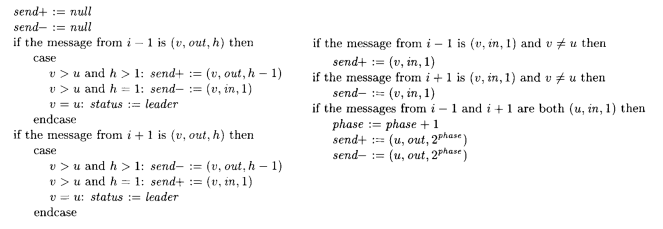5: Leader Elections
1/21
There's no tags or description
Looks like no tags are added yet.
Name | Mastery | Learn | Test | Matching | Spaced |
|---|
No study sessions yet.
22 Terms
Synchronous Network Model
A directed graph, often representing nodes in a system, where messages can be exchanged with each other.
G = (V, E) with a fixed alphabet M
Distance
The shortest path between two nodes is the length of the shortest path between those two nodes.
Distance of a Graph
The maximum distance between any two nodes.
Synchronous Network Model - Node Contents
statesi - set of states
starti - starting states
messagesi - message generation function
transi - state transition functions mapping statesi and vectors
Synchronous Network Model - Edge (Channel) Contents
Either nothing, or a single message M.
Synchronous Network Model - Process
All processes (nodes) begin in arbitrary start states
All channels (edges) are empty
Processes repeat continually:
Apply message-generation function to current state to generate a message sent to all outgoing neighbours
Messages are put in appropriate channels
Apply the state-transformation function to the current state and incoming messages to obtain the new state
Remove all messages from channels
Synchronous Network Model - What Can Go Wrong
Link failure - channel loses messages
Stop failure - process stops mid-execution
Byzantine failure - an arbitrary message/state is generated that doesn’t follow the rules of the message generation/state transition functions
Leader Election Problem
The problem of choosing a “leader” node in a network and holding the data necessary for the function.
Leader Election Problem - Variations
Unidirectional/Bidirectional Path
Number of processes may be known or unknown
Non-leaders may be required to acknowledge that they are not the leader
Unique IDs may be consecutive integers or not
Unique IDs may admit operations other than comparison
Leader Election Problem - Safety Specification
There is at most one leader in the system.
Leader Election Problem - Liveness Specification
Sometimes, there exists a leader (either no correct node exists or a node is eventually elected leader).
Leader Election Problem - Problem Modelling (Token Ring Network)
Network is a connected ring
Nodes have consecutive unique identifiers
Synchronous model
Each node knows its right and left neighbour
Addition is module-N
Unidirectional ring of unknown size
LCR Algorithm
A solution to the Leader Election Problem by electing the process with the highest identifier.
LCR Algorithm - Process
A process notes a lack of leader and initiates an election.
It creates an election message and passes it to neighbouring nodes.
When a node receives an election message:
The receiving UID is checked against its own UID
If the receiving UID is bigger, then the node continues passing the original election message
If the receiving UID is smaller, then the node passes on a new election message containing its own UID.
The node becomes a candidate.
If a candidate receives an election message:
If the UID is its own, then it is the leader.
If its UID is not its own, then the election is lost.
The leader sends a message across the network informing other nodes it has been elected.
LCR Algorithm - Liveness
A process imax outputs a leader by the end of round n.
We know umax is the initial value of uimax by initialisation
The values of u never change and are distinct by assumption
imax has the largest u value by definition of imax
Suffices to show that after n rounds, statusimax = leader
LCR Algorithm - Safety
No process other than imax ever outputs the value leader.
All other processes always have the status = unknown
LCR Algorithm - Message Complexity
O(n2)
n rounds before a leader is elected
LCR Algorithm - Halting
All processes never reach a halting state.
We can add a “finished” message initiated by the elected leader.
2n rounds before a leader is elected, but message complexity remains the same
Hirschberg and Sinclair (HS)
A solution to the Leader Election Problem by sending a token in each direction before returning back to the origin node.

Hirschberg and Sinclair (HS) - Process
Each process, i, operates in a phase, e.g. 0, 1, 2…
In phase l, process i sends out “tokens” containing its identifier ui in each direction
Intended to have travel distance 2l before returning back to i
If both tokens make it back safely, then process i continues the following phase
Whilst ui is proceeding in the outbound direction, each other process j on the path compares ui with its own identifier, uj
If ui < uj then j discards the token and returns its own
If ui > uj then j relays ui
If ui = uj, then process j has received its own identifier before the token has turned around, so it elects itself leader
Hirschberg and Sinclair (HS) - Message Format
<id, direction, hop_count>
Hirschberg and Sinclair (HS) - Individual State Contents
u, a unique ID
send+, containing either an element of M or null
send-, containing either an element of M or null
status, {unknown, leader} (initially unknown)
phase, non-negative int (initially zero)
message generation function:
Send the current value of send to process i + 1
Send the current value of send to process i - 1
